The best players in the world are also the quickest—they can change direction on a dime, split defenders with a feint and leave them spinning, and glide past a challenger who thinks he has him bottled up in a corner. To succeed at the highest level, you need to not only be able to see things before they happen—you need to react faster than anyone else. That’s what great footwork does for you as a player: it puts you one step ahead of everyone else, so when an opportunity presents itself, you’re ready to take advantage of it.
Soccer Footwork Fundamentals
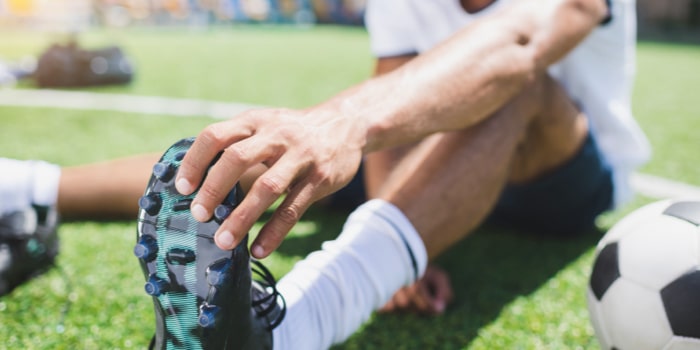
Great footwork is the product of good fundamentals. That means you need to have a solid base from which to move—otherwise, you might as well be trying to run across a wobbly table. Your base is your balance, which is determined largely by your posture. To have great posture, you need to be aligned properly: your hips and knees bent, your back straight, your shoulders over your hips. The closer you are to that position, the more stable you’ll be, which will allow you to generate more power with each step and cut, and will make it harder to knock you off balance.
Increase Your Agility and Shifting Speed
One of the biggest impacts that your footwork can have on your game is your ability to change directions. Soccer is a game where you’ll typically be moving in one direction and then quickly switching directions to avoid a defender or to get past them. This can be a little bit trickier than it sounds because it means that you’ll need to quickly switch the placement of your feet while moving in a different direction. This is known as your “shifting speed” and is a great way to add some more excitement to your game.
By improving your agility and shifting speed, you’ll be able to quickly change the direction of your movement with very little effort. This will allow you to quickly react to the movements of your teammates and defenders so that you can find the best position for you to make a play. Agility training can be done with many different types of exercises. We recommend doing things like jumping rope, ladder drills, and even simple footwork drills that incorporate these movements.
Develop Your Rotational Fitness
Another important aspect of improving your footwork is building up your rotational fitness. This is the fitness that allows you to rotate your hips and core in order to change the direction of your movement. Essentially, it means that you’ll be able to quickly jump into a different direction and then change back to your original position.
Rotational fitness is especially important for players who spend a lot of time on the ball. With each pass and dribble, you’ll be spinning your hips and core in order to get the ball where it needs to go. If you don’t have the appropriate level of fitness, you’ll find that your movements are slower and less accurate.
Learn to Change Direction While Running
In order to truly improve your footwork, you should also strive to learn how to change directions while running. This is a very common occurrence in soccer and many other sports, so it’s important that you are ready. By practicing changing directions while running, you’ll be able to quickly change the direction of your movement no matter how fast you’re going. This will allow you to avoid defenders while also making sure that your team always has the best position possible to score goals.
If you are able to change directions while running, you’ll be able to move around the field with ease and confidence. This will make it much more difficult for your opponents to mark you and you’ll be able to take advantage of any mistakes that they make.
Footwork Drills Types
1. Dynamic Footwork Drills
The best way to practice your footwork is to do it while moving at speed. You’ll be able to focus on getting your body positioned correctly while building up the necessary speed and rhythm to make the footwork truly effective. These drills will help you improve your soccer agility, speed, and footwork, as well as your fitness level.
2. Right Foot Drills
This is one of the simplest right-foot footwork drills out there, but it’s also one of the most effective for improving your agility, footwork, and dribbling.
- First, you start with your right foot on a wall behind you. Your left foot is planted in front of you—with your knee bent, as if you’re about to jump out of a push-up position.
- Then all you have to do is drop your right foot to the ground and hop back up, taking 6-8 inches off the wall with each pass.
- You can increase the difficulty of the drill by moving the wall forward, or making it so that you have to switch feet in mid-air to land on your right foot.
3. Left Foot Drills
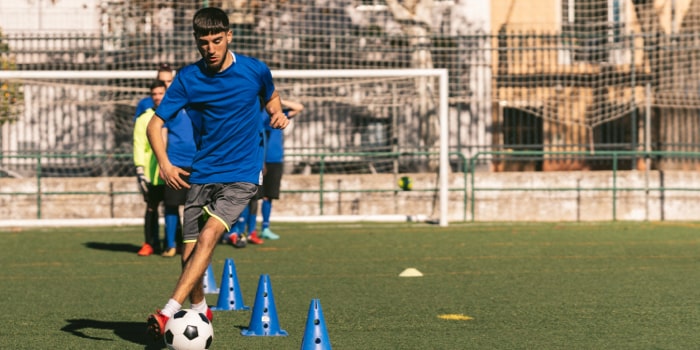
This is a great left-foot footwork drill that helps you improve your agility and footwork.
- Start by standing on a soccer ball with your right leg on top of it, and your left foot on the ground. That’s your starting positiot.
- Then, simply jump and switch legs, landing on your left foot, and having your right leg on top of the ball.
- You can increase the difficulty of this drill by increasing the speed at which you perform it, or by adding in a few jumps in mid-air.
4. Ankle-Breaking Shuffle Drills
One of the best ways to improve your footwork is by doing ankle-breaking shuffles.
- First, stand about 18 inches from a wall and start with your right foot.
- Then, take a large step towards the wall with your right foot, followed by a quick shuffle with your left foot towards the right, followed by a large step with your right foot back towards the middle, followed by a quick shuffle with your left foot towards the right, and then a large step with your right foot back towards the middle.
That’s one rep—do 15 of those, then repeat the same thing but with your left foot.
5. 360 Shuffles Drills
This is a variation on the ankle-breaking shuffle drill, but it focuses on 360-degree cuts, which are much more common in soccer.
- Again, start by standing about 18 inches from the wall with your right foot out.
- Then, take a large step towards the wall with your right foot, followed by a quick shuffle with your left foot towards the right, followed by a large step with your right foot back towards the middle, followed by a quick shuffle with your left foot towards the right, and then a large step with your right foot back towards the middle.
That’s one rep—do 15 of those, then repeat the same thing but with your left foot.


Improve Your GameJust 1.99 p/m
Exclusive drills and sessions, get involved today!
- 100’s of Drills
- Coach to Camera Videos
- Sessions from Pro’s
- Industry Leading Advice
6. Box Shakes Drills
Shuffles are great for improving your footwork and agility, but they’re not the best when you’re in tight spaces or surrounded by defenders. Box shakes give you the same benefits while giving you room to breathe.
- Start by standing with your right foot on one side of a soccer ball, and your left foot on the other side.
- Then, simply switch feet, right to left, and left to right, like you’re shaking a box full of DVDs—the ball is the box.
That’s one rep—do 15 of those, then repeat the same thing but with your left foot.
7. Sprinter Shuffle Drills
This is an advanced footwork drill, so you won’t want to do it too often—but as an occasional workout, it’s great for improving your agility and footwork.
- Start by standing about 10-15 yards from a wall, and then start running towards the wall. When you’re about 5 yards from the wall, switch your feet, like you’re doing a quick, mini shuffle.
- Then, when you’re about 3 yards from the wall, switch your feet again. When you’re about 1 yard from the wall, switch your feet again, and then finish by spinning and running back the other way.
That’s one rep—do 10 of those.
8. Propping Shuffle Drills
The main difference between this drill and the previous one is that this one involves a little bit of extra momentum, which makes it a bit more challenging.
- Start by standing about 10-15 yards from a wall, and then start running towards the wall. When you’re about 5 yards from the wall, lift one foot off the ground, and then switch your feet, like you’re doing a quick, mini shuffle.
- Then, when you’re about 3 yards from the wall, lift the other foot off the ground, and then switch your feet again. When you’re about 1 yard from the wall, switch your feet again, and then finish by spinning and running back the other way.
That’s one rep—do 10 of those.
Free Grassroots Fun Soccer Games eBook

Keeping players on top of their game throughout the season is critical, and small-sided games are ideal for this. There are over 50 activities in this guide to help you do just that.
Download Free NowCupello Footwork Drills
1. Receive On the Back Foot
An open body position on the back foot helps a player move in any direction, as he can see where the spaces are on the pitch and where his mates might be in a better position to pass the ball, if they receive it on the back foot.
2. Dribbling in a Crowd
Players can surge past defenders to get into free areas on the field by dribbling out of congested areas.
3. Passing Diamond
Keeping possession is dependent on having the ability to pass and receive effectively, and this exercise will help players improve their technical ability to receive with an open body, play forward, and combine.
4. Washington DC Control Passing
The players must perform well in a five-sided passing exercise, demonstrating good passing and receiving skills. Receiving on the back foot and crisp, accurate passes without the ball bobbling are required to make receiving easier.
5. Chip The Goalkeeper
Chelsea dominated Arsenal in the Women's FA Cup final, and Sam Kerr's audacious dipping goal was a fantastic piece of skill and a great finish. Use this drill to get your players chipping goals.
Coaches Final Thoughts
These dynamic footwork drills are designed to increase your speed, agility, and footwork. The best way to improve your footwork is to practice it at full speed, so these drills are the best way to do that. In addition to these drills, you can also try to incorporate footwork into your regular soccer sessions. Incorporating it into your warm-up is a great way to get your feet ready for the day, and you’ll be ready to go when you need to be.
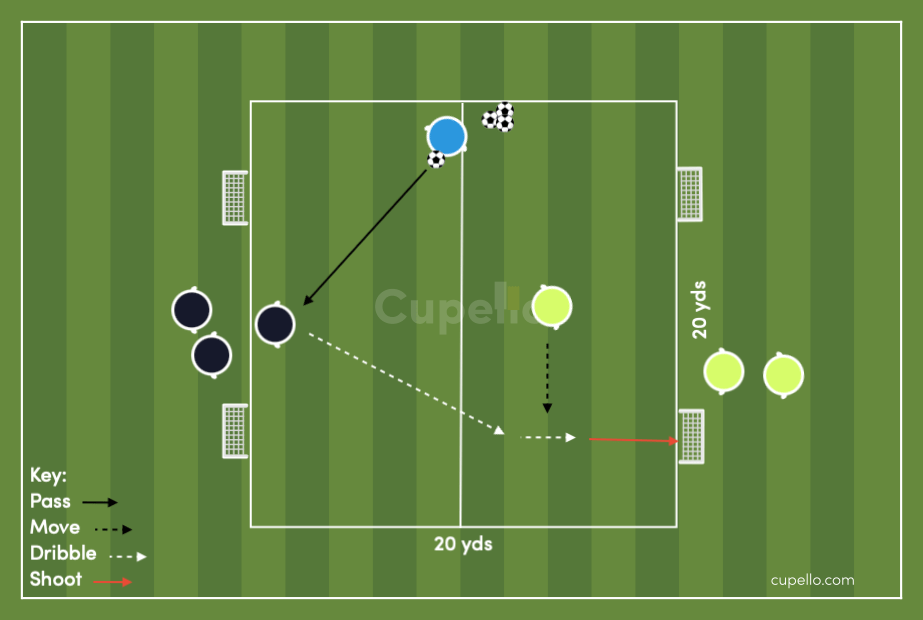
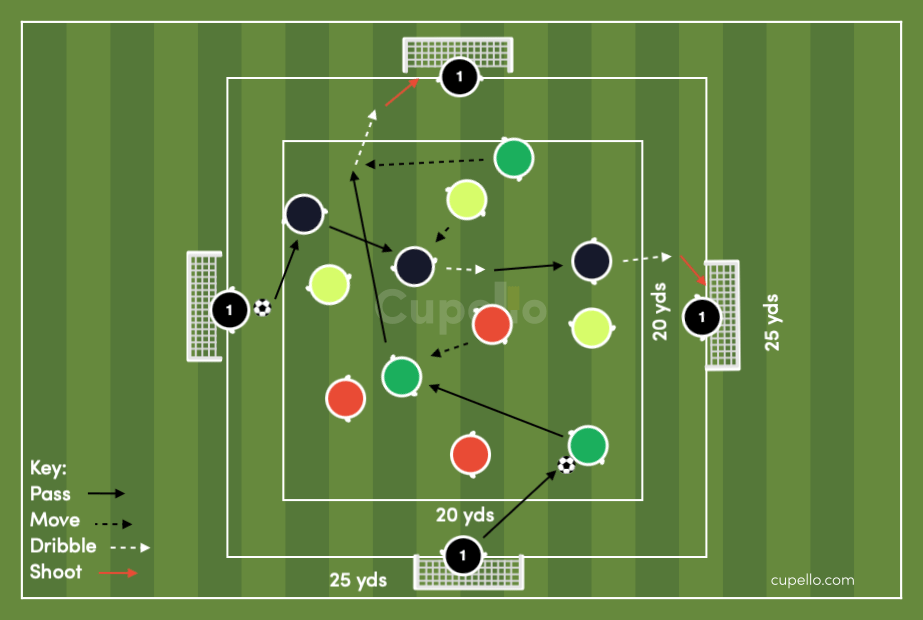
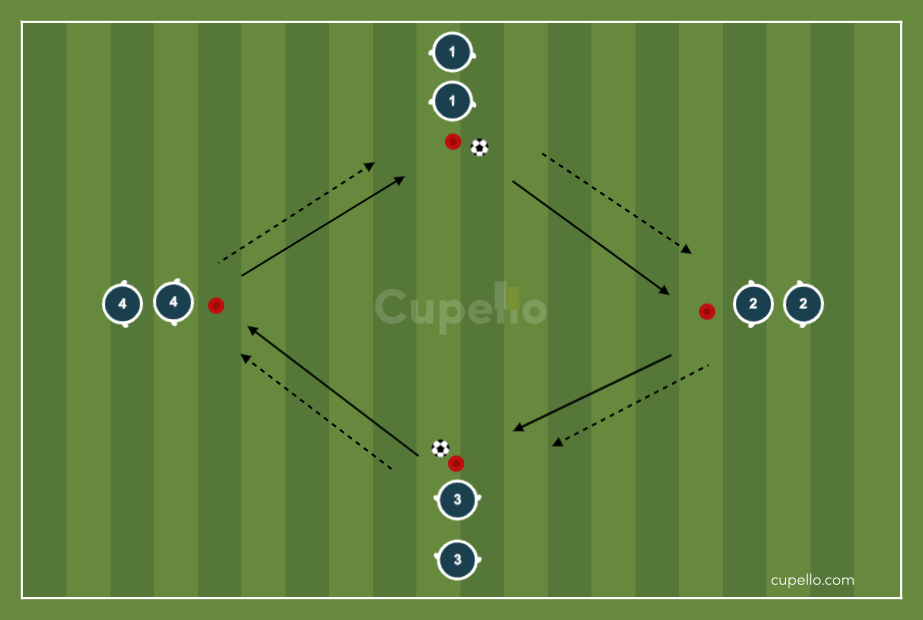
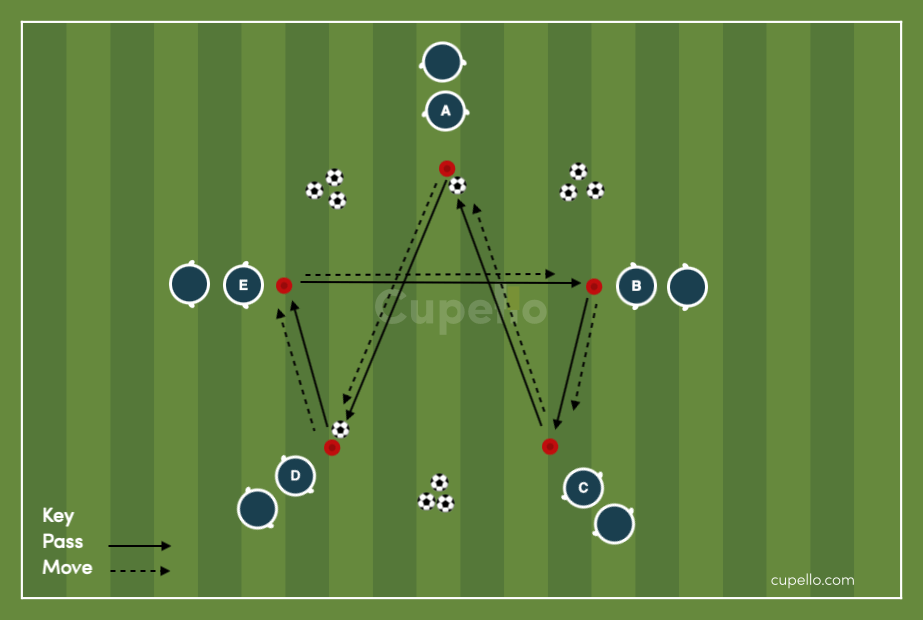
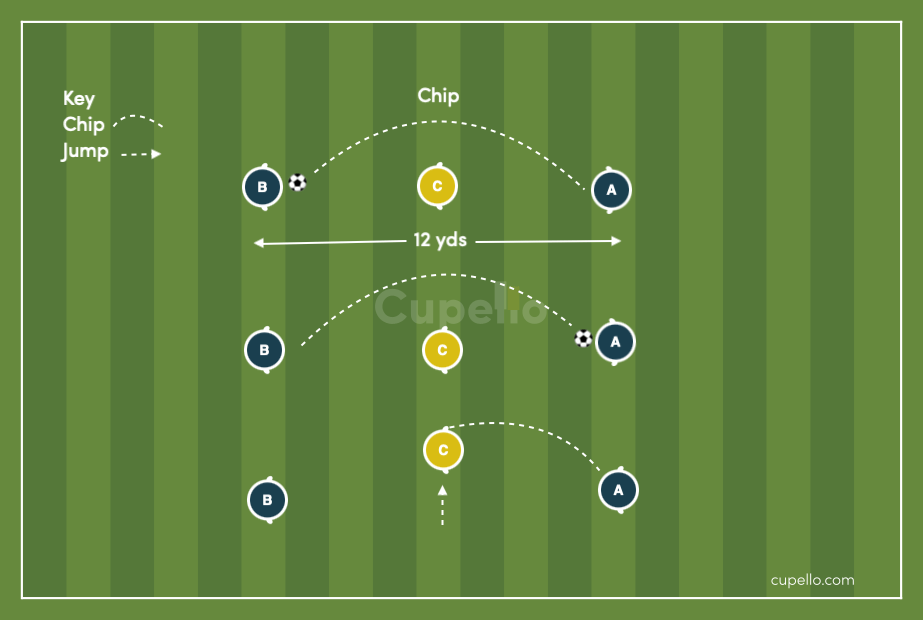
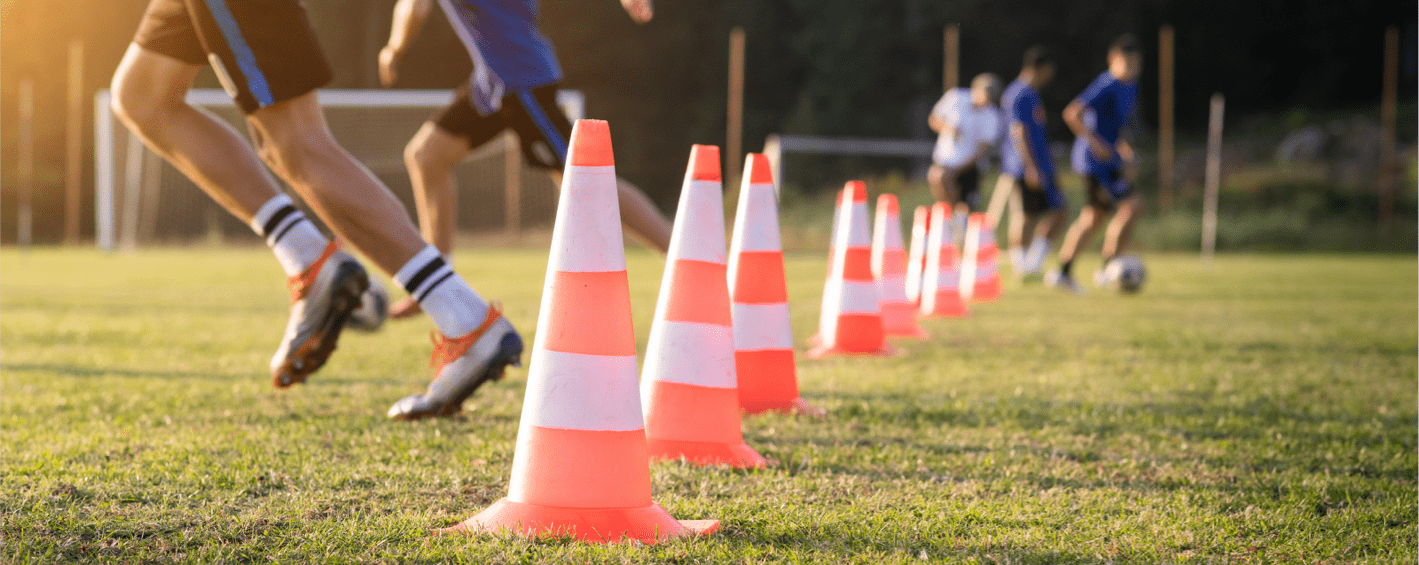
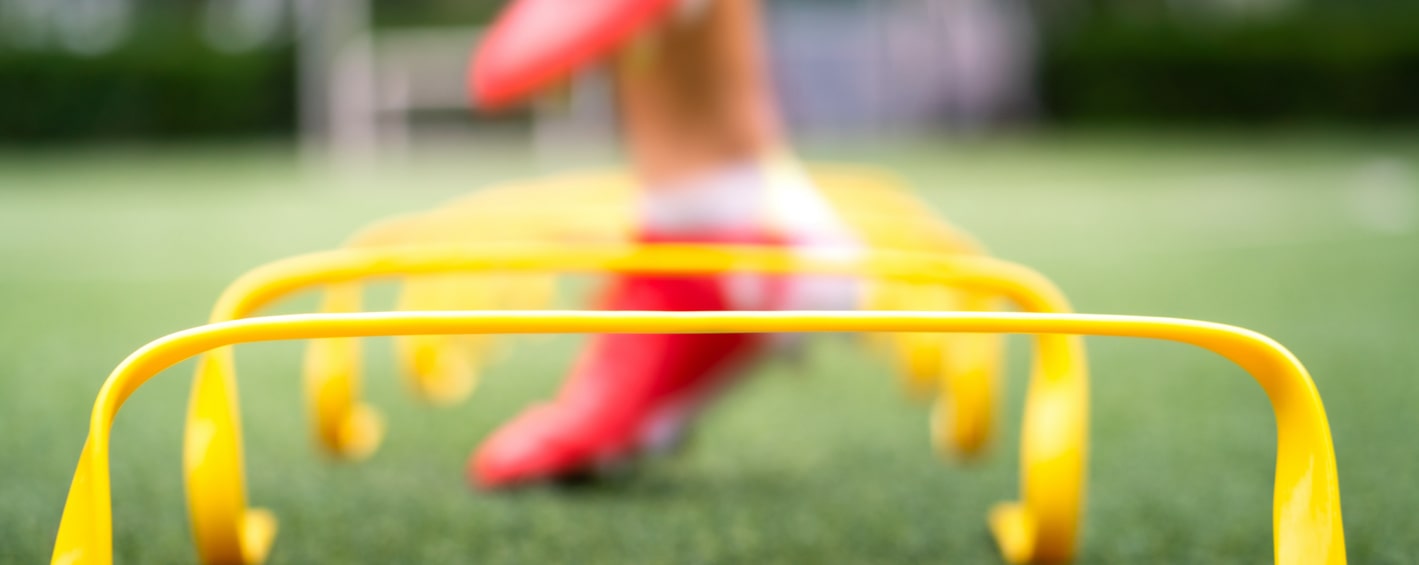
Cupello
Rethinking soccer coaching via our industry leading tools. Built to offer effective coaching development solutions for players and coaches of all levels.